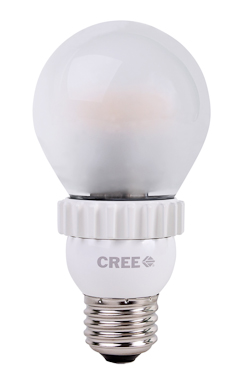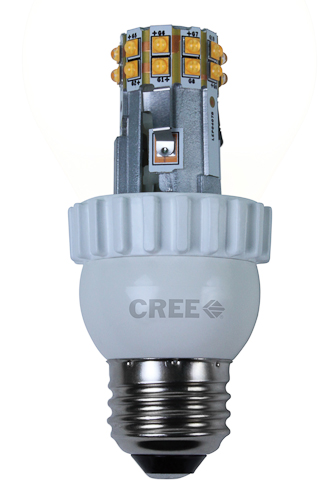Cree Introduces an LED Bulb Edison Would Love
If you’ve had any experience with LED light bulbs, you know they can look pretty odd. Cree today introduced a bulb that mimics the traditional incandescent bulb design in every way–except its inefficiency.

The bulb is the first consumer bulb from Cree, which primarily supplies LED semiconductors to other lamp makers. There are three products: a 40-watt equivalent and two 60-watt equivalents with different color light. They’re available from Home Depot online now and will be made available in stores this month priced between $9.97 and $13.97.
What’s most notable is that bulbs have the same glass dome as incandescent lights and there isn’t a large metal heat sink. The first wave of general-purpose LED products have heavy metal fins to wick away heat from the LED light sources, which helps ensure life. The Cree bulb uses the same glass as an incandescent but has a rubber coating to prevent shattering.
In an incandescent bulb, a tungsten filament in the center of the glass glows to give off an even, warm light. Cree designed a “filament tower” that places a series of pin-hole-shaped LEDs in the same location as the traditional filament. I installed one yesterday and the effect is a similar light output as a traditional bulb and even light distribution.
Having a familiar shape is very important to spur more consumers to consider LEDs as a replacement for incandescent bulbs, says Mike Watson, the vice president of corporate marketing. “Consumers actually love that particular (incandescent bulb) product. It’s the shape they’re used to and it gives off a warm glow they expect, but it’s grossly inefficient and has a short lifetime,” he says. Cree’s bulb uses high-power LEDs which means it can work with a smaller heat sink, which appears like a collar around the base of the bulb.
An incandescent bulb lasts about 1,000 hours, while most LED bulbs are rated to last 25,000 hours, which can be 15 or 20 years depending on usage. The Cree bulb has a 10-year warranty.

A 60-watt equivalent Cree LED bulb that gives off 800 lumens uses 9.5 watts for the warmer-colored light. The color rendering index, a measure of light quality, is at least 80.
Other LED lighting companies are also changing their designs with the hopes of appealing to more consumers. The first LED bulbs from Philips looked a bit like a crown because its yellow-colored phosphors were placed on top of the bulbs. In response to consumer requests, Philips has adopted a lighter-weight heat sink and moved the phosphor in its latest products so it better resembles the classic incandescent bulbs.
Keep Reading
Most Popular
Large language models can do jaw-dropping things. But nobody knows exactly why.
And that's a problem. Figuring it out is one of the biggest scientific puzzles of our time and a crucial step towards controlling more powerful future models.
The problem with plug-in hybrids? Their drivers.
Plug-in hybrids are often sold as a transition to EVs, but new data from Europe shows we’re still underestimating the emissions they produce.
How scientists traced a mysterious covid case back to six toilets
When wastewater surveillance turns into a hunt for a single infected individual, the ethics get tricky.
Google DeepMind’s new generative model makes Super Mario–like games from scratch
Genie learns how to control games by watching hours and hours of video. It could help train next-gen robots too.
Stay connected
Get the latest updates from
MIT Technology Review
Discover special offers, top stories, upcoming events, and more.